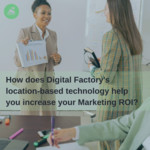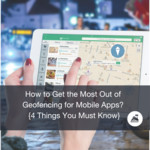The Key to Accelerating Brands
-
 Micro Fence
Micro Fence
-
 Read in: 4 mins
Read in: 4 mins
- by: Alexis Prousis
Marty McFly: Hey, Doc, we better back up. We don't have enough road to get up to 88.
Dr. Emmett Brown: Roads? Where we're going, we don't need roads.
If you don't know the above movie dialogue, it's from the 1985 classic Back to the Future. And now, 30 years since the movie's premiere, we're living in a world, that well, as Christopher Lloyd's Dr. Brown so prophetically said, “Where we're going, we don't needs roads.” And, he was pretty right. We're living in the age of digital, the age of mobile, and on the horizon is the age of robots and self-driving cars. We technically don't need roads anymore to get us to where we want to go—we need technology.
A recent survey conducted by Forrester found almost half of mobile users expect an app to be designed for their convenience. Apps for when and how we do things are now not only complements to our lives, but also have become staples to our daily routine.
When it comes to mobile, apps are where most consumers experience the mobile web. In fact, 90% of mobile online time is spent in-app, versus mobile browser. And, when it comes to mobile apps, users not only want apps to make life easier, they expect it.
This is where geo-fencing can fit seamlessly. The benefits of geo-fencing include receiving an offer on a drink on a hot day, to being alerted when your credit card bill is due when you are near your local bank.
A consumer's life can be affected by geo-fencing in four key ways: utility, engagement, gamification and real-time offers.
1. Utility
In a study released last month, 20% of apps are only used once by consumers before being deleted. After getting consumers to download them, apps need to demonstrate utility to get people coming back again and again.
With precise location targeting, geo-fencing is able to send notifications and content to consumers at the most opportune times, by incorporating handset information (location, direction,), accessible first-party data (past purchases, preferences, etc.) and relevant third-party data (time of day, weather conditions, etc.). This enables the delivery of real-time user-specific content that lets users see apps in a new light - more than nifty additions to our smartphones, but as instruments that can direct, find, offer and inform.
Half of the battle of downloading applications onto mobile devices is the ads, notifications and services that stray away from the user's interest. People view their mobile devices as a loyal companion, so when an app offers utility it adds value to an app beyond just a brand product or offer.
From notifying you about the safest roads to drive on, to alerting you of a high electricity usage, the best utility apps out there make life a little less hectic and create a sense of efficiency for users.
2. Engagement
According to a NinthDecimal study, 86% of consumers reported they were likely to discover a new brand or product on their mobile device when notified. This gives an incentive for apps to actively drive engagement with an audience.
Applications that are actively engaged with users offer a mutually beneficial experience. For business owners, engagement confirms brand and store awareness, and for mobile app users, it is an effective way of bringing real-time information, including content, news updates and offers.
Geo-fencing can drive consumers to enjoy content due to its relevance – which ultimately drives consumers to re-open the app and encourage app-related behaviors. Such behaviors could include sharing on social media platforms like Facebook, Twitter and Instagram or inviting friends to try a new brand or website and receive a credit.
Relating to each user in a specific way not only incentivizes engagement, but also builds user loyalty. Geo-fencing achieves this kind of relevancy through location and timing - by giving users information at opportune moments relevant to where they are and what they want.
3. Gamification: Scavenger hunts, Sweepstakes, Customer Loyalty, Rewards Points
Gamification refers to game-like tactics and strategies such as points, levels and leaderboards that brands incorporate into loyalty programs and sweepstakes to engage with consumers.
Now, with mobile devices, brands have the ability to drive consumers on the go or in-store through the integration of geolocation into brands' mobile apps by using an array of customer loyalty programs, sweepstakes and scavenger hunts. This “gamification” is a great way to activate engaged brand enthusiasts and shoppers in new ways that drive involvement and loyalty.
For example, brands can add urgency and activation to their offers by adding time requirements, check-ins and multiple locations so shoppers can participate in a deeper, more meaningful way.
4. Real-Time Offers
Mobile devices have re-made sales promotions, offers and coupons for the new age – one where location and real-time delivery are a critical part of the use-case.
With geo-fencing, brands can target consumers near specific stores and/or based on past purchase behavior to deliver coupons when and where they are most relevant. Would you be more likely to redeem a coupon to Bloomingdale's if it popped up on your phone just as you were passing the store on Michigan Avenue? Statistics say yes. One study showed 57% of smartphone users stated they would likely shop at a store if they received relevant deals near that store.
Where we're going we don't need roads—that's what Dr. Brown said. And after, breaking down the four ways geo-fencing can accelerate brands and consumers, it seems as if he was right. Roads may be part of the journey, but it's technology that's moving us forward.







